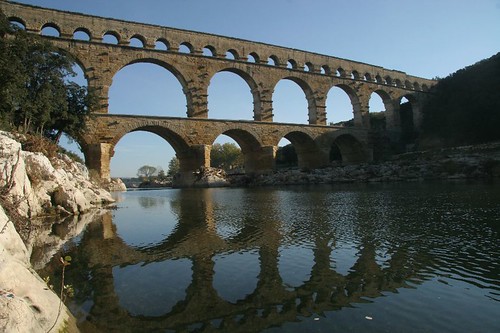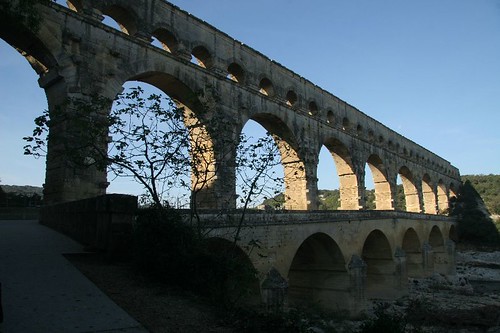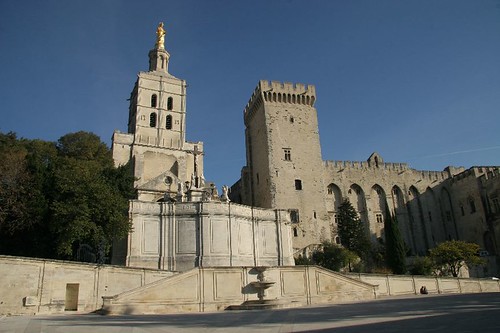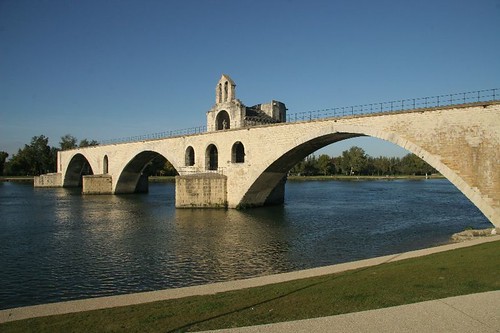Ventimiglia, Italy. November 9
It was an early night last night, so I woke up quite early as well. It wasn’t quite a full moon, but it was bright enough to create distinct shadows. I started cooking breakfast in the dark as it slowly lightened. Breakfast consisted of some leftovers from our supper supplies last night as well as part of our “emergency” supplies that we may as well start to use up since there isn’t too much time left on our trip. So we had goat cheese on toast along with mushroom soup for breakfast. Different, but it was tasty.

We packed up and headed on our way out to the Pont Du Gard, which was just a few kilometres away from where we were camping.
The Pont du Gard was perhaps Bethany’s most anticipated single desitination on our trip. She has been to Europe before and has seen the famous sights in Paris and Rome, but not the Pont du Gard. She also has a thing for bridges, so this very well preserved old Roman aqueduct bridge was on her list of things she has to see in her lifetime.
The Roman colony of Nîmes was built around a spring, but this was not sufficient as the colony expanded. They located another source of clean, fresh water, but this was about 50 kilometres away over hilly terrain. This didn’t faze the Romans, since Nîmes was a colony favoured by and dedicated to Augustus. So they built an aqueduct through the hills and over the valleys to reach Nîmes. The bridge at Pont du Gard was the highest aqueduct bridge built by the Romans at 147 metres, and is one of only two that is well-preserved. The aqueduct stopped being maintained in the 4th century, yet continued to carry water for 5 centuries more. Many of the well-dressed stones were then stolen for building elsewhere, but the massive stones constructing the bridge were mainly left alone. No maintenance was done until the time of Napoleon III, attesting to the skill of the Roman architects and builders.
No mortar, only iron clamps, was used between the stones, and the arches are independent of each other to allow for subsidence in the ground and fluctuations in the river flow. The scaffolding supports were deliberately left on the bridge to allow for maintenance as well as for aesthetics. The bridge is really something that has to be seen.

After taking lots of pictures of the Pont du Gard, we cycled down to Avignon to catch a train to Italy. We got some good news at the station: we could catch a French train to Ventimiglia, Italy rather than having to bicycle from Nice to San Remo. The French agents were unable to sell us tickets on the regional Italian trains. These are the only ones that will take a fully assembled bicycle; the international trains do not. Taking the train will allow us to spend an extra day in and around Florence, which Bethany claims is the most beautiful in Italy (that she has seen).

We had a couple of hours before our train left, so we were able to head into Avignon to see the Papal palace as well as the Pont St. Benezet (a.k.a the Pont D’Avignon).
As many of you are probably aware, the Pope lived in Avignon during most of the troubled 14th century, both before the schism, and then the French popes lived there after the schism. Avignon must have been quite the place during this time; many criminals and other unsavoury sorts came to Avignon to enjoy the amnesty of the popes. The papacy was quite the money maker during the 14th century, and the popes spent much of this in Avignon, each building a larger and larger palace.

But Avignon was rich before the popes arrived. “Sur le pont d’Avignon, l’on y danse tous en rond”, as the song goes. Built in the 12th century, the bridge was the only place to cross the mighty Rhône river, and collected a large amount of money in tolls. However it cost a lot of money to maintain, so it stopped being maintained in the 17th century and most of the bridge fell in a flood. However, 4 arches do remain.
After this day of bridges, we boarded the train to Italy. Italy is our 6th country this trip and once again we are experiencing a language where pretty much our only exposure is the movies. Ciao.